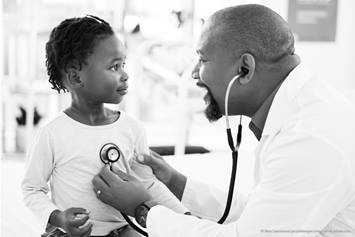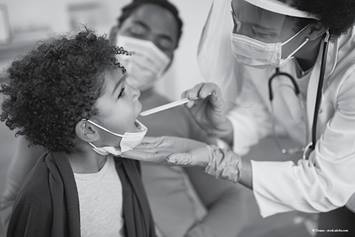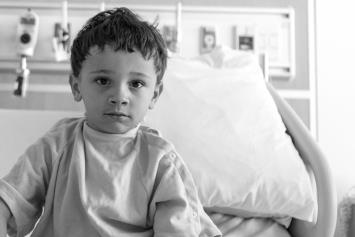Bronchiolitis
Bronchiolitis happens in the small airways (bronchioles) that branch off from larger airways (bronchi). The bronchioles swell, narrow and fill with mucus, making it hard to breathe.
Bronchiolitis (bron-key-oh-LIE-tiss) is an infection of the breathing (respiratory) system caused by a virus, usually respiratory syncytial virus (RSV). Other viruses that can cause it are the flu, the common cold, human metapneumovirus and adenovirus. These viruses are very contagious. A person catches the virus by touching or breathing in the mist, drainage (secretions), mucus or saliva from an infected person’s nose or mouth.
Bronchiolitis happens in the small airways (bronchioles) that branch off from larger airways (bronchi). The bronchioles swell, narrow and fill with mucus, making it hard to breathe.
Bronchiolitis is most often seen in children under 2 years of age in the fall and winter. A child can get it more than once each season.
Early Signs
- Runny nose and stuffiness
- Fever is possible
- Coughing (lasts about 3-4 weeks)
- Irritability
Later Signs
- Fast and shallow breathing
- Pauses in breathing for 15 to 20 seconds or longer (apnea)
- Skin pulls in between ribs and neck when breathing (retractions)
- Changes in skin color - pale skin, blue color to fingers, toenails, nose, or lips
- Head bobbing
- Frequent coughing spells (lasts about 3 to 4 weeks)
- Wheezing and tight breathing (Gets worse for 2 to 3 days, then starts to get better. Wheezing lasts about for 7 days.)
- Less interest in eating
- Not as playful and gets tired easily
Diagnosis
Your child’s health care provider will:
- Take a health history, do an exam and listen to their chest
- May swab the inside of their nose to test for the virus
If your child is very sick, the health care provider may:
- Check their blood oxygen level with a pulse oximeter. This a painless sensor that is put on the child's finger or toe.
- Order blood tests and a chest X-ray.
Home Treatment
Since a virus causes bronchiolitis, antibiotic medicines will not help. Here are some things you can do to make your child more comfortable:
- For coughing and mucus build-up (congestion), use a cool mist vaporizer. The moist air may make breathing easier and reduce coughing. Do not put medicine in the vaporizer. Change its water every day and clean between uses.
- For a stuffy nose, use salt water (saline) nose drops to loosen the mucus. Then suck the mucus out with a suction device like a NoseFrida® or a baby bulb syringe.
- For fever, give children:
- over 2 months - acetaminophen (Children’s or Infant’s Tylenol®).
- over 6 months - acetaminophen or ibuprofen (Children’s or Infant’s Motrin®, Advil®)
- Do not give aspirin or products that contain aspirin to any child.
- Do not give cold and cough medicines to a child under 4 years of age.
- Do not give honey to children younger than 1 year of age.
- Give lots of fluids – small amounts at a time and often. Also do this with formula or breast milk.
- Do not give fruit juice or water to a child under 12 months of age. Do not give Pedialyte® without asking the health care provider first.
- For children older than 12 months of age, give Pedialyte® and liquids like water. These do not replace the need to still eat their usual foods. Limit fruit juices or liquids high in sugar.
- Check your child’s temperature using a digital thermometer. Never use a mercury thermometer.
- Rectal (in baby's bottom) thermometers are most accurate. The next best choice is a forehead (temporal artery) thermometer. An armpit (axillary) temperature can be used as a quick check, but it is not very accurate. Do not use an oral thermometer until your child is 4 years old.
- Choose a thermometer based on your child's age:
- under 3 months - rectal or forehead thermometers
- 4 months or older - rectal, forehead, or axillary thermometers
- older than 6 months - rectal, forehead, ear, or axillary thermometers
- 4 years old or older - oral (mouth), forehead, ear, or axillary thermometers
- Be sure to tell your child's health care provider which method you used.
If Your Child Is Hospitalized
Your child may:
- Be connected to a sensor to watch the heart rate and oxygen level.
- Need oxygen. This is usually given using a nasal cannula (plastic tubing with small prongs in the nose) or a mask. See the warning below.
- Have an IV placed to give fluids and some nourishment. Often a child with bronchiolitis has a hard time eating and drinking.
- Need their nose suctioned with a bulb syringe, NoseFrida, or small tube connected to a suction machine to remove mucus.
- Be treated with salt water drops before suctioning to loosen the mucus in the nose.
- Need special treatment if they are younger than 3 months of age, have a severe infection, or have a history of heart or lung disease.
Warning
- The medical device tubing can get wrapped around a child’s neck. This can lead to choking (strangulation) or death.
- DO NOT leave the medical device tubing where infants or children can get tangled up in it.
- Talk to your child's health care provider:
- If your child has been tangled in their tubing before.
- To learn steps you can take to help make sure the tubing does not get wrapped around your child’s neck, such as keeping the tubing away from the child as much as possible.
- Any other concerns you may have about the risk of strangulation from medical device tubing.
- If your child is injured by the medical device tubing, please report the event to the FDA. Your report can provide information that helps improve patient safety. The website to make a report is: www.accessdata.fda.gov/scripts/medwatch/index.cfm?action=reporting.home
To prevent spreading viruses to others:
- Wash your hands often, before touching your baby or handling food. Wash hands after sneezing, coughing, using the bathroom, or changing diapers. Ask others to do the same.
- Sneeze or cough into a tissue or into your shirt sleeve, turned away from people.
- Do not share personal items like pacifiers, towels, toothbrushes, drinking glasses, cups, bottles, forks, or spoons.
- Wash your baby’s toys and clothes often.
- Keep people who have colds away from your baby. This includes brothers and sisters.
- Do not smoke around your baby or let others smoke around them.
Keep your child home from school or childcare when they are sick.
When to Call Your Health Care Provider
Call your child’s health care provider if your child:
- Gets worse or starts wheezing after going home from the hospital.
- After 2 days of being sick, is still not able to eat.
- Has apnea, trouble breathing, or is breathing very fast.
- Looks pale or skin, fingers, toes, or lips turn bluish
- Has retractions when breathing.
- Cannot sleep.
- Has a high fever.
- Younger than 3 months of age and has a temperature of 100°F (38°C) or higher
- Older than 3 months of age and has a temperature
- Of 100.4 F (40 C) or above.
- Above 102 F (38 C) for more than 2 days or keeps coming back.
- That has been treated to bring it down, but it has not worked.
- At any age and has a fever and:
- Looks very ill, is very fussy, or very drowsy.
- Is not eating or drinking and shows signs of dehydration - dry or sticky mouth, sunken eyes, dark urine, dry diapers, or not urinating.
- Has a stiff neck, a bad headache, very sore throat, a painful stomach ache, vomiting, or diarrhea.
- Has an unusual rash.
- Has been in a very hot place, such as an overheated car.
- Has immune system problems that make them more likely to get sick, such as sickle cell disease or cancer, or takes medicine that weakens the immune system.
- Cannot be comforted when being held or fed.
Call 911 or go to the emergency department if your child has trouble breathing, has a seizure, or is hard to wake up.
Helping Hands Patient Education Materials
Written and illustrated by medical, nursing and allied health professionals at Nationwide Children's Hospital, Helping Hand instructions are intended as a supplement to verbal instructions provided by a medical professional. The information is periodically reviewed and revised to reflect our current practice. However, Nationwide Children's Hospital is not responsible for any consequences resulting from the use or misuse of the information in the Helping Hands.
HH-I-31 | ©1985, revised 2022, Nationwide Children’s Hospital



